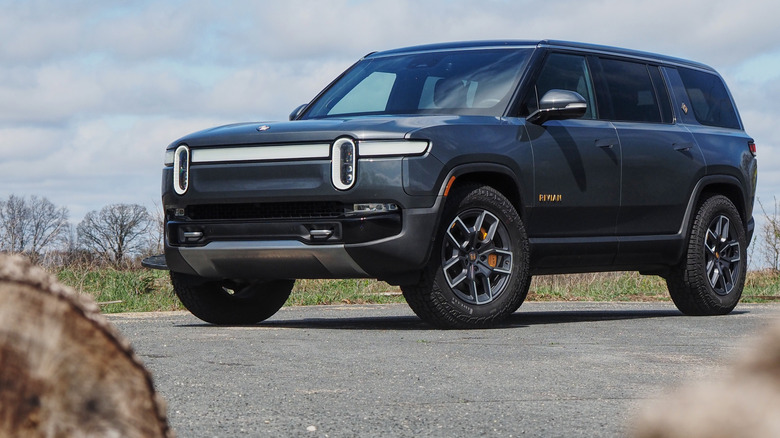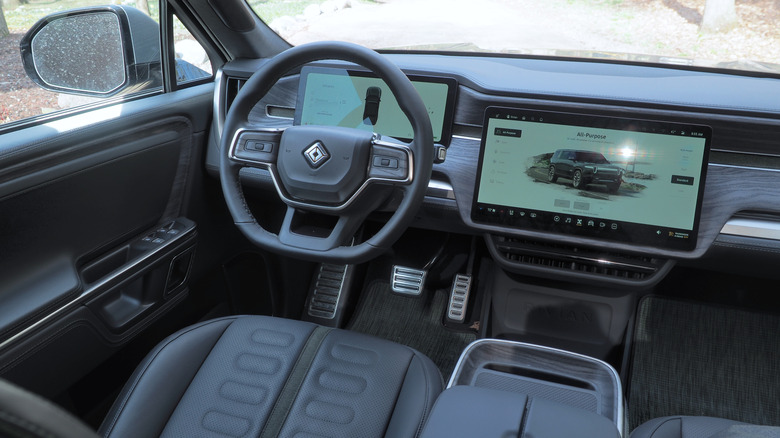This Big Feature Is Still Missing From The Rivian R1S
The Rivian R1S has a lot to recommend it. Second model from the automotive startup, the SUV takes the platform of the R1T electric pickup and turns it into a three-row family hauler. In quad-motor form, it's unexpectedly potent — capable of doing zero to 60 mph in just 3.0 seconds — while with 7,700 pounds of towing capacity and 14.9 inches of ground clearance, it's practical, too.
As we found in our Rivian R1S review, that adds up to a compelling prospect, electric or otherwise. Though options for EV SUVs have been growing in number over the past few years, your choices for three-row versions are far more limited. That might make it a little easier to overlook some of the Rivian's foibles. The expensive sticker price — $92,000 for quad-motor AWD and the Large battery pack — is one such pain point, while the overall scale and 321 miles of range could give some drivers second thoughts. However, it's the dashboard technology where some potential R1S buyers might find a dealbreaker.
A big touchscreen, but no CarPlay or Android Auto
As we've seen on other recent vehicle launches, Rivian has condensed most of its functionality into a sizable dashboard touchscreen. There, drivers can manage navigation, adjust multimedia, switch between the R1S' drive modes, and monitor charging whether at home or at a public DC fast charger. When it comes to connecting a phone, however, don't expect either Apple CarPlay or Android Auto.
Though support for Apple and Google's smartphone projection systems is more common than not, Rivian is one of the few hold-outs that has skipped the technology. Instead, you get Bluetooth connectivity through which you can stream audio such as music or audiobooks, make hands-free calls, and typically use your smartphone's voice assistant.
Navigation, though, is left to Rivian's own system. The R1S (like the R1T) has standalone apps for services like Spotify and TuneIn, which can stream through the electric truck's embedded 4G LTE modem. Some services — like Apple Music — are conspicuous by their absence, however.
Rivian's decision is about control over the dashboard
Back when we first drove the Rivian R1T and noted the absence of Apple CarPlay and Android Auto, the automaker was coy about when it might be adding them. It did, though, highlight its over-the-air (OTA) update support, which would theoretically allow Rivian to add features like smartphone projection to existing EVs. Whether that's actually going to happen, though, seems doubtful.
Speaking to Marques Brownlee, Rivian CEO RJ Scaringe painted a bleak picture for those holding out hope for Apple or Google's systems. "A lot of the things we do, like whether it's music or mapping, we have to make sure we integrate in with the best-in-class platforms," Scaringe said on the WVFRM podcast. "By controlling the system it just allows us to be the arbiter, the head chef, in terms of the experience you get. Versus handing over control of what we think is one of the most important parts of the experience."
Rivian isn't alone in seeing dashboard tech through that lens, and in fact, it'll soon find itself with new members in the CarPlay and Android Auto hold-out club. General Motors announced back in March 2023 that its upcoming EVs would not include either the Apple or Google systems, arguing that it was able to deliver a better experience with native software that benefited from tight integration with the underlying hardware in the car.

